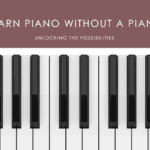We all know practice makes perfect. But simply plunking away at the piano keys doesn’t guarantee you’ll get better. To truly master the piano, keeping consistent rhythm and timing is key. That’s where your new best friend comes in: the metronome.
You’ve likely seen the odd-looking device marked with beats per minute (BPM) before. Maybe you’ve even tried using a metronome app. But do you really understand the power this unassuming tool holds? Let’s change that.
In this article, we’ll explore how to use a metronome for piano practice. You’ll uncover why it’s so critical for improvement. And pick up some metronome exercises to target everything from technique to musicality. Before you know it, you’ll be keeping perfect time – and wowing audiences.
Understanding the Metronome
What Is a Metronome?

A metronome is a practice tool that produces a steady beat to provide a consistent tempo reference. Traditional mechanical metronomes have a swinging pendulum, while modern digital metronomes can produce a variety of sounds, helpful for playing along with metronome exercises. There are also metronome apps available on phones or tablets.
The speed of the metronome click is measured in beats per minute (BPM), which is crucial when you learn how to play the piano. By adjusting the BPM, you can set an appropriate practice tempo, from very slow to extremely fast.
Brief History

The first mechanical metronomes were created in 1812 by Johann Nepomuk Maelzel and Dietrich Nikolaus Winkel. These early models had limitations in terms of adjustability and reliability. Over the next century, various inventors continued to refine metronome design, utilizing new technologies as they emerged.
In the late 20th century, digital metronomes offered increased accuracy and features. Today, musicians can choose from mechanical, electronic, or software metronome options to suit their practice needs.
Types of Metronomes

There are three main types of metronomes available today, each suitable for different methods of learning to play the piano.
- Mechanical metronomes use an inverted pendulum and escapement mechanism to produce the rhythmic beat. They are wound up manually and do not require batteries.
- Digital metronomes use a microchip to electronically generate the click. They allow for greater precision in BPM settings and added features like accents, subdivisions, and memory functions. They are battery-powered.
- Metronome apps provide software-generated beats through phones, tablets, or computers. They offer the benefits of digital metronomes along with enhanced customization and accessibility.
Benefits of Using a Metronome

Incorporating metronome practice into your piano studies can provide the following musical benefits:
Enhances Timing and Rhythm
The metronome’s steady pulse develops your internal clock, allowing you to play with reliable timing. This rhythmic foundation is key for accuracy and consistency.
Aids Memorization
Practicing gradually with a metronome “chunks” the music into your muscle memory more efficiently. This facilitates quicker memorization and retention of pieces.
Improves Sense of Rhythm
The metric subdivision exercises enabled by a metronome strengthen your understanding and feel of rhythmic patterns.
Facilitates Tempo Mastery
You can incrementally increase the tempo with a metronome to methodically work up the speed of difficult passages. This allows you to polish pieces to performance level.
Aids Ensemble Playing
Developing your rhythmic sense prepares you to sync accurately with other musicians in ensemble playing.
Setting Up Your Metronome
To optimize your metronome practice, follow these guidelines:
Select Appropriate Tempo
Choose a BPM marking suited to your technical proficiency with the piece or exercise. Start slowly and increase the tempo gradually.
Set Time Signature
Input the correct time signature of the music to ensure the metronome aligns with the beats, an essential step to play along with a metronome. This enhances the rhythmic feel.
Adjust Metronome Settings
Tweak options like sound, volume, accents, and subdivisions to cater the metronome to the specific piece.
Techniques for Effective Metronome Use
Employ these methods to get the most out of practicing with a metronome:
Start Slowly and Increase Tempo
Beginning at slower BPMs ensures accuracy. Then incrementally raise the speed to expand your capabilities.
Isolate Rhythm First
Practice just the rhythm of a section without the notes first to internalize the beat. Then add the melody.
Utilize Subdivisions
Activating metronome subdivisions facilitates conquering tricky polyrhythms and syncopations.
Set Gradual Tempo Goals
Establish realistic BPM goals for pieces to maintain motivation and track improvement.
Try practicing with this free online metronome tool:
Exercises to Practice with a Metronome
The following focused exercises will develop key rhythmic skills:
Basic Rhythms
Reinforce feeling quarter, eighth, and sixteenth notes with the metronome. Play basic rhythmic patterns as a way to practice piano playing.
Scales and Arpeggios
Practice scales and arpeggios with a metronome to improve timing consistency within technical passages.
Challenging Passages
Use the metronome when learning troublesome sections in your pieces. Isolate and loop them to ingrain the rhythm.
Dynamic Changes
Maintain steady tempo with the metronome while practicing dynamic fluctuations to control pacing.
Rubato Passages
While preserving the inner pulse, practice gradually modulating the tempo for rubato passages.
Tips for Overcoming Common Challenges
You may encounter these difficulties initially when practicing with a metronome:
Getting Used to the Sound
Persist through the unfamiliarity of playing along with the click. It will soon feel natural.
Frustration with Slow Tempos
Appreciate the long-term benefit of a gradual tempo increase, despite the early monotony.
Maintaining Consistency
Schedule regular metronome practice to make it a habit, preventing rhythm decline over time.
Advanced Metronome Techniques
Those with some experience can try these more advanced methods to learn to play piano with a metronome.
Polyrythms and Odd Time Signatures
The metronome facilitates conquering the complex rhythms of polyrhythms and meters like 5/4 or 7/8.
Silent Beats
Occasionally muting the metronome click will test and strengthen your internal pulse awareness.
Common Misconceptions
Some think that long-term metronome use can make you dependent on the click while playing. However, the goal is to eventually internalize the steady pulse to develop your own inner rhythm sense. With mindful, focused practice, the metronome simply accelerates this process.
Conclusion
We hope this guide has shown you the immense value of incorporating metronome practice into your piano studies. Developing your rhythmic accuracy and tempo mastery will make you a well-rounded musician. Be patient in implementing these methods, and with time, your rhythm skills will flourish.
The metronome will quickly become an indispensable tool. Allow it to guide your progress as you continue your piano journey, setting the metronome as a companion.





